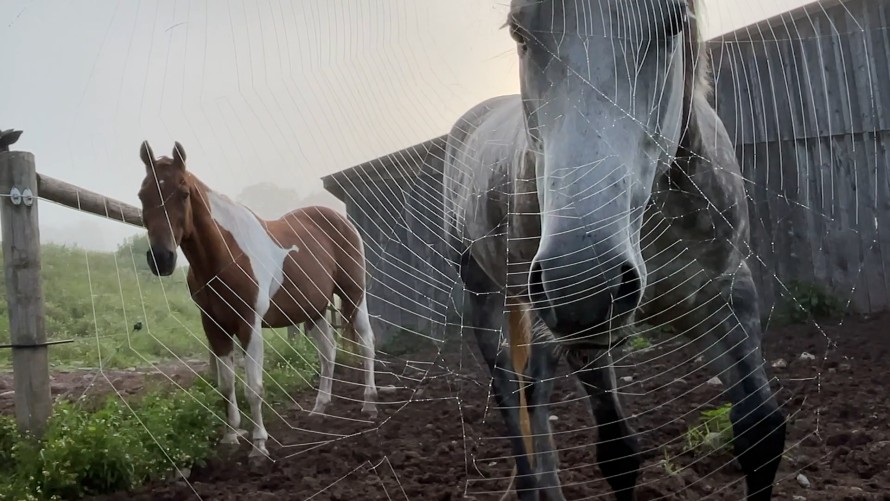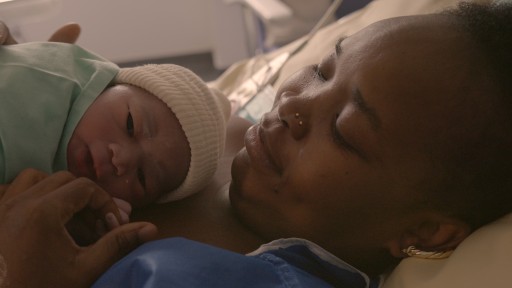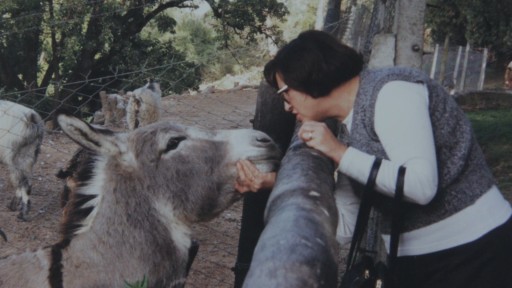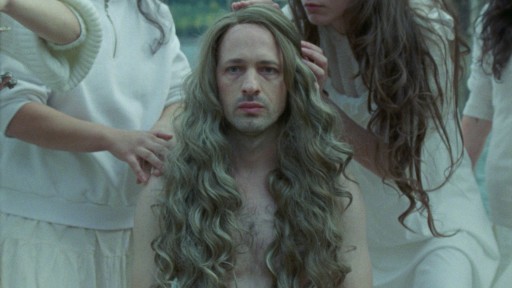2023 | Forum
Within the Symptom
Voices from off-screen, private images that always have a political dimension: this year’s selection of the Forum not only broadens the view, it also challenges our sense of hearing. Section head Cristina Nord discusses the rediscovery of cinematic forms that were believed to be long-forgotten, changes of perspective and discrepancies between image and sound as well as the “retrospectives of the future”.

Horse Opera by Moyra Davey
The Forum programme has a lot going on in the audio tracks: voice-overs which, in the case of Viera Čákanyová’s Poznámky z Eremocénu (Notes from Eremocene), are completely disembodied and perhaps also without consciousness; monotonous in Horse Opera by Moyra Davey; like a poetry slam in This is the End by Vincent Dieutre. Can you tell us a little about the intriguing and widening gap between sound and image?
During the selection process, we were surprised by how often we encountered films in which the voice-over plays an important part and also by how many of them we liked. Alongside the ones mentioned above, there’s Arturo a los 30 (About Thirty) by Martín Shanly, Gehen und Bleiben (Leaving and Staying) by Volker Koepp, Între revoluții (Between Revolutions) by Vlad Petri, Dearest Fiona by Fiona Tan and Unutma Biçimleri (Forms of Forgetting) by Burak Çevik. Some of these works use an off-screen voice in a more conventional sense, as something that comments on, makes sense of or highlights certain aspects in the progression of the plot. In Gehen und Bleiben, Volker Koepp has texts by Uwe Johnson read out while the camera pans across the landscapes of Mecklenburg-Vorpommern. Others are more radical, most notably Poznámky z Eremocénu with voices created by artificial intelligence. Horse Opera also springs to mind because it doesn’t just feature the off-screen voice of the director Moyra Davey but, to start with, a very quiet voice that the director listens to through headphones before she repeats the text. This explains why, rather than being a modulated, varied and dynamic voice-over, it seems rather snatchy.
How do you explain this increased incidence?
First of all, by the fact that apparently no cinematic tool ever becomes obsolete, even if it does go out of fashion for a while. For a long time, text, dialogue and language as a means of cinematic expression weren’t particularly highly regarded. For people who attach great value to the composition of the image and consider cinema to be primarily a visual medium, voice-overs are like a red rag to a bull. In the same way, the zoom shot is not widely appreciated because it’s too close to the aesthetics of television. Then along comes Hong Sangsoo and shoots film after film with zooms. I don’t have a readymade explanation for why voice-over is so popular right now, but I can speculate: maybe the gap between language and image is due to the fact that we’ve just experienced three years in which quite a lot has fallen apart. The pandemic has brought with it various forms of dissociation. We meet in virtual spaces and have a presence there without being physically present: the “I” in the meeting with others has become detached from the body while the physical “I” stays at home. So there are already quite a few movements that are drifting apart from each other and asynchronicities that need to be processed. Please don’t think I’m being critical of contemporary culture here: a lack of being intact, not being one with yourself, is unavoidable in any case; what matters is how you deal with it.

Dearest Fiona by Fiona Tan
In Dearest Fiona and Între revoluții, private letters are read out aloud while we see historical archive footage on-screen. The private meets the public.
Fiona Tan’s film contains footage that is around 120 or 110 years old. It shows everyday life in the Netherlands: dykes being built, fishing nets hauled in, ships unloaded, the harvest brought in, and so on. Then there are the letters read off-screen. They are letters that Tan’s father wrote to her after she left Australia for Amsterdam as a student in the late 1980s. At first glance, the images have nothing to do with the sound. Thus, it’s up to the viewer to wonder, to figure it out, to keep an eye out for underlying connections. These exist, and become evident when Dutch colonial history sometimes hoves into view – for example when boxes from Sumatra are unloaded from a ship’s hull – which in turn is linked to Tan’s family history. It is very subtle and open to interpretation. The opposite of didactic.

Între revoluții by Vlad Petri
And in Între revoluții?
Things are rather different there because the letters heard in the voice-over are fictitious texts. The writer Lavinia Braniște condensed them from a wide variety of documents. What is striking here is the contrast that develops between the public images, sometimes created for propaganda purposes, and the more intimate texts. There is a contradiction between the official images, which convey an ideological notion of womanhood, and the lived experience that is almost suffocated by the enforced conformity.
How intimate is this year’s selection?
I’d like to answer that with a somewhat clichéd phrase: the private is political. The ideas that an individual has about attachment, intimacy, love, family, relationships and how they conceive themselves are extremely connected to the ideas that a society recognises, accepts and promotes. Or rejects. This is very evident in Între revoluții. The relationship that exists between the two fictitious letter writers isn’t even mentioned because, in the Romania and Iran of the 1980s, there’s no concept of lesbian desire. Another film I’d like to draw attention to here is Claire Simon’s Notre corps (Our Body). It spends almost three hours exploring a gynaecological clinic in Paris, showing us consultations, procedures and births, including a caesarean section. A 16-year-old girl has an unwanted pregnancy, a trans teenager receives advice about hormone therapy and upcoming operations, a young woman suffers from endometriosis, a cancer patient has no further treatment options left.

Notre corps (Our Body) by Claire Simon
Watching this documentary made me realise what “embodied”, an adjective that’s been quite ubiquitous lately, actually means. How we position ourselves in relation to the world, the possibilities of perception and cognition available to us and how we feel pleasure has a lot to do with the kind of body we are in and the experiences to which this body is exposed. For example, a 16-year-old becoming pregnant after her boyfriend promised to be careful: is that a purely individual matter? Or does it have something to do with the fact that young women, 50 years after the second women’s movement, still find it difficult to articulate their interests, while young men apparently learn wonderfully well how not to give a damn about the interests of anyone else? And I don’t mean all of this in an essentialist way, but with a view to which gender roles are being accepted.

Anqa by Helin Çelik
There are several other documentaries that grant glimpses into private and intimate worlds: for example, Luís Alejandro Yero’s Llamadas desde Moscú (Calls from Moscow) with its telephone conversations and the intimacy of a small apartment, and Helin Çelik’s Anqa with its disturbing accounts from the survivors of misogynist violence.
Yes. What I find fascinating about both films is that the plight of the protagonists reflects back on the films themselves in a certain way. This is perhaps a little less the case with Llamadas desde Moscú but the waiting, the perseverance, the prolonged, empty time definitely seeps into the film. With Anqa, it is pronounced because the logic of the trauma suffered by the three women pervades the film and shapes it insofar as it offers neither an outside perspective nor does it help us make sense of anything. Anqa intentionally fails to create any distance; it is, if I can put it this way, within the symptom. And here, once again, individual distress is intertwined with the situation in society. The fact that the women in Anqa do not dare to leave their homes, and that the young Cuban queers hardly leave their Moscow apartments in the late winter of 2022, is far from being down to purely personal reasons.

Irene Bosch in El rostro de la medusa by Melisa Liebenthal
Does this sometimes seem a little voyeuristic? For example, the peephole lens that frames the animals in Horse Opera. Or rather, not necessarily the whole animal but individual body parts, often the genitalia.
You could look at it in that way. But I actually think these circular apertures are among the cinematic forms that had sunk to the bottom of film history and are now reappearing, either by chance or because Horse Opera has a telescope in one room and the film wants to replicate its gaze. One could, of course, be reminded of John Berger’s book, “Why Look at Animals?”, which discusses how the animals that humans coexisted with in premodern times became marginalised by the industrial revolution and how they then, via the spectacle of the zoo or circus, once again became part of the human sphere. Incidentally, Berger can also be used as a reference point for Melisa Liebenthal’s El rostro de la medusa (The Face of the Jellyfish).
That’s one of no fewer than three films from Argentina. Is there a kind of Argentina focus this year?
Argentina is a very productive country when it comes to cinema. Interesting films find their way to us every year and our consultant Luciano Monteagudo is a great support. There is also a personal reason: a long time ago, I took a degree in Latin American studies which of course included Argentinian literature. A film like El rostro de la medusa, in which a young woman has a face that isn’t her own, reminds me of the short stories of Julio Cortázar in which something entirely impossible is often accepted as a matter of course. This quiet form of the absurd is something that resonates with me. It’s a similar case with Ulises de la Orden’s El juicio (The Trial), even if that film creates a different type of resonance. It compiles video footage shot by Argentinian television during an important trial in 1985. Two years after the end of the military dictatorship, members of the junta were put on trial and there were several cameras in the courtroom. The director has edited the material into an almost three-hour film and, as it focuses on the testimonies, a picture gradually emerges of the extent and method of terror exerted by the military over the population. El juicio is a film that represents one of the tendencies in the Forum that I consider to be very important: it is one of the works that attempt to find cinematic forms of expression for injustice and political crimes. Regarding Argentina, we should also mention Jonathan Perel here: in 2020, his film Responsabilidad empresarial (Corporate Accountability) screened in the Forum, and Camuflaje (Camouflage) in 2022.

Mehran Tamadon and Mazyar Ebrahimi in Jaii keh khoda nist by Mehran Tamadon
Jaii keh khoda nist (Where God Is Not) by Mehran Tamadon also comes to mind: three Iranian exiles in Paris recall the imprisonment, interrogation and torture to which they were subjected before they were able to leave Iran. They talk about their experiences and also re-enact them. In Tamadon’s film, the locations – the Iranian prisons – are reconstructed in Paris; the process has something forensic about it. The new location merges with the original and becomes it, but the perspective of the victims is a different one: they are looking back at themselves – as if from another place.
Yes, this is also a film that poses the question of how and for what purpose injustice experienced in the past can be brought to life via the cinema. Does the re-enactment have a cathartic effect? Or does it once again trap the three ex-convicts in this experience of violence? Having never been forced to experience political violence myself, can I understand their experiences when they recreate the positions in which they were tortured? And what about the director’s desire to touch the hearts of the torturers by depicting the suffering of those who have been tortured? The film certainly interrogates itself. It more resembles an experimental setup than provides a clear answer.
And the director continues this self-questioning in another film, Mon pire ennemi (My Worst Enemy), which is being presented in Encounters.
Yes, although fictionalisation plays a bigger role in that film. I find it is also important that, although the three former prisoners in Jaii keh khoda nist are addressing experiences that happened a long time ago, contemporary Iran – with its repression, imprisonments and death sentences – is also evoked. It enrages me whenever I think about how that regime treats its opponents.
In which ways does Selma Doborac’s De Facto compare to the films of Ulises de la Orden and Mehran Tamadon?
Rather than focusing on the experiences of victims, De Facto uses the perspective of the perpetrator without, however, sympathising with it. There is no mention of specific places and crimes, although anyone who has read a newspaper or followed the news over the past few decades will recognise a few things. The setting is minimalistic, almost abstract: in long takes, two actors take turns to speak texts compiled from court records, statements by those involved and witnesses, manifestos, philosophical treatises. The two are poised on the border between speaker and character. This is a daring and, at the same time, important contribution to determining how film can deal with historical and contemporary events, exploring and analysing the perspective of those who commit atrocities.

István Téglás in Mammalia by Sebastian Mihăilescu
This adds up to a lot of political crimes, a lot of terror and many atrocities. Does the programme also offer a counterbalance?
Two years ago, the guest management team of the Forum was new and our younger colleagues had quite clear ideas about what makes a Forum film: austere, inaccessible and not very much fun. Then they watched the whole selection and were surprised because they found many things that were happily running wild, for example Doch rybaka (Tsarevna Scaling) by Uldus Bakhtiozina and Esquí (Ski) by Manque La Banca. It is similar this year. Yes, we have De Facto and W Ukrainie (In Ukraine) by Piotr Pawlus and Tomasz Wolski, but we also have the deadpan humour of El rostro de la medusa, a comedy of errors such as Arturo a los 30 and Sebastian Mihăilescu’s Mammalia, a feature film which deals with masculinity in crisis but has a big heart for the surreal and has also learnt something from folk horror. Or Le Gang des Bois du temple (The Temple Woods Gang), a gangster film by Rabah Ameur-Zaïmeche that fulfils the genre requirements while at the same time allowing itself to go on many wild digressions.

Oyoyo by Chetna Vora
Which aspects would you like to highlight regarding this year’s Forum Special?
This year, we’ve compiled the “Fiktionsbescheinigung” (Certified Fiction) series with Karina Griffith, Can Sungu and Jacqueline Nsiah. The programme comprising ten short, medium-length and feature-length films goes back quite a long way to works from the 1970s, 80s and early 90s and is presenting, among other things, captivating examples of German-Turkish cinema such as Yüksel Yavuz’s Mein Vater, der Gastarbeiter. There are also films by Chetna Vora and Gautam Bora who studied film in Babelsberg around 1980, both of which are no less captivating. And Sohrab Shahid Saless, the great nihilist of New German Cinema, also finds a place with Ordnung (Order), a feature film about petrified German souls. The films from Babelsberg and Saless’s oeuvre are currently being restored – finally, it’s about time! But there’s still no restored version of Ordnung available, so the audience is having to make do with a 16mm copy in which the nuances are lost in the darker scenes. And we are screening a working copy of Chetna Vora’s Oyoyo. Incidentally, this less than optimal copy situation is testament to the fact that these films have had a marginalised existence and sometimes remain in that state to this day.
Can you elaborate on the phrase “the retrospectives of the future” that’s mentioned in the press release?
It's about time that this marginalisation changed, because these films deserve our attention. When I speak of the retrospectives of the future, I mean that “Fiktionsbescheinigung” provides a sketch for something to come. Cinematheques, film festival retrospectives and festivals dedicated to rediscovered films can turn this sketch into a painting. And if they are still hesitating, at least in Berlin there’s a place called “Sinema Transtopia” where a transnational perspective on film heritage is being celebrated.